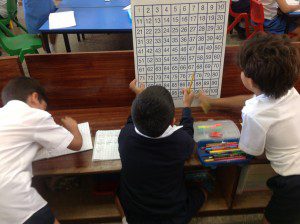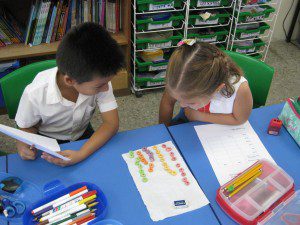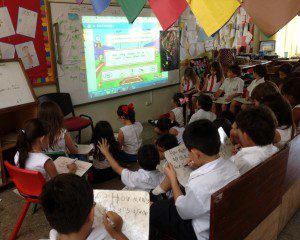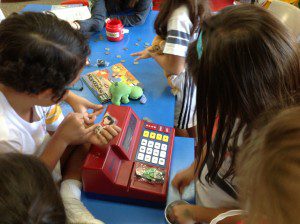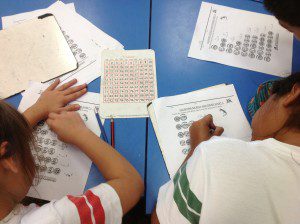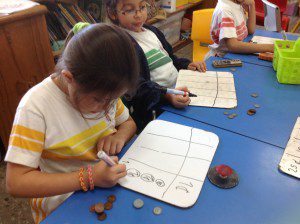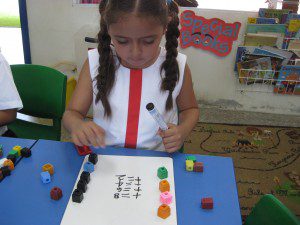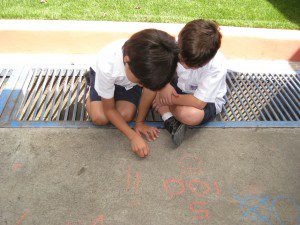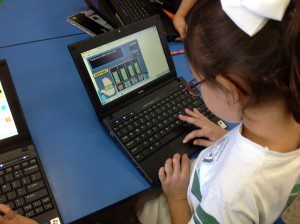Progression in students’ understanding of mathematics is a fundamental focus for policy in many countries, where the relationship between mathematical standards and the quality of the workforce, which maintains economic competitiveness, forms part of the government’s rationale for wanting to improve numeracy standards. Recurring periods of national concern about low standards of numeracy skills shown by Primary school pupils have become more urgent and more political in recent years with the publication of international comparisons of mathematical achievement (Street et al., 2005, pp.1). In the UK, the National Curriculum offers a model for progression of learning in mathematics, and as with teaching across the developed world, this shows a focus in the way in which children learn as active problem solvers. Implicitly, this defines the ethos of constructivist’ theories of how children learn and is based on the view that learners need to be actively engaged in constructing their own mathematical knowledge by seeking out meanings and making mental connections in an active manner.
Mathematics is both a body of established, recognised content and a process by which exploration and establishing takes place. As Brown (1989, pp. 126) states, there is mathematics to know and mathematics to do. Atkinson (1992, pp. 16) puts forward the view that the ability to solve problems is at the heart of mathematics. In the context of these widely accepted definitions of mathematics, progression in children’s understanding of mathematics requires that in addition to having some knowledge of mathematical facts, concepts and skills, children are able to put their knowledge to work for the purpose of solving problems. Engaging in the processes of mathematical activity enables children to assimilate the associated skills and knowledge.
The role of the teacher can be viewed as crucial for enabling children to understand mathematics. As pointed out by Orton (1995, pp. 13), considerable emphasis in learning mathematics in recent times has been placed on the desirability of understanding rather than on being able to repeat remembered routines and demonstrate particular basic skills. Progression then, can be seen as the development of a child’s ability and confidence to tackle the nature and purpose of mathematics whilst being able to explore and utilise a variety of mental strategies. There are many factors that facilitate progression, including the features of effective teaching and the extent to which pupils need to be accommodated.
For teachers to best support children’s progression in their learning of mathematics, they must first plan lessons appropriately. Logically, this planning should be underpinned by an understanding of how children think and learn. As pointed out by Anghileri (1995, pp. 26), the new understandings which derive from all the current research into the processes by which children think and learn have clear and major implications for teaching mathematics to young children. Above everything else, the main implication is that it is the teacher’s responsibility to nurture a positive attitude towards the subject of mathematics. In my own lessons that I taught, I certainly found that the pupils were much more engaged in learning when they enjoyed the activities that were associated with learning.
For example, I would make regular use of the interactive whiteboard for the purpose of virtual activities, which I found were effective in getting the children actively interested in the topic. Where possible, I made use of games that the children could play in pairs and groups. For one particular lesson on fractions, decimal & percentage equivalences, I got the children playing a game of dominoes in groups in which the object was to match the correct equivalences. Interestingly, I tended to find that the use of games was not always conducive to forming a good basis for progression in children’s understanding, since as much time would be spent on understanding the actual game as it would on gleaning understanding of the mathematics involved. They might well enjoy the activity of playing a game but the learning is often minimal. In addition, I would say that the effectiveness of any game or ‘enjoyable activity’ is largely determined by the extent to which it places mathematical problems in meaningful real world contexts.
Indeed, making mathematics enjoyable should go hand in hand with making mathematics meaningful. This is the means by which anyone makes sense of
anything new with which they are faced, by relating it to what is already known. As explained by Askew (1992, pp. 26) ‘children working in Brazilian street markets demonstrated a range of mathematical skills and knowledge, which they had problems demonstrating in formal tests’. Arguably, activities used in classrooms need to mirror the sort of situations to which mathematics is actually applied. This must mean that this way of human learning is vastly inhibited when one is presented with information or experience that does not relate at all to what is known. Obviously, this has clear implications for the teaching of progression children’s understanding of mathematics and leads a skilful teacher to place mathematics into a context in which the children are familiar.
Research, however, has shown that while practical work and ‘real’ contexts can be useful, they need to be chosen carefully, and accompanied careful dialogue with the pupils to establish the extent of their understanding (Askew, 1992, pp. 11). This has been confirmed by my own experience, as it is easy to spend too much time getting resources to fit a particular theme or context but which can detract from the learning outcome. In order to get pupils really understanding mathematics, it is commonly agreed that pupils need to be supported in giving verbal explanations where they can talk through what they are doing, since this is an essential step in ‘going mental’. Anghileri (1995, pp. 20) looks at the importance of children giving verbal explanations in terms of it being conducive to developing their cognitive awareness and control – that is, their ability to learn how to learn. This means children should be encouraged to be reflective about their own processing, and to adapt and develop strategies, which put them in control. In fact, this explains to a large extent the ethos behind the ‘mental and oral starter’. It is clear across all year groups that mathematical language used by the teacher regularly draws on ‘open-targeted’ questions, requiring the children lo explain how they solved a problem. Insofar as helping children to learn strategies for understanding and applying mathematics, the mathematical language and mental strategies used is, according to Anghileri, important for enabling children to cope with what is known as structural limitation – that is, their limited memory capacity. This is achieved through children developing their selective attention, in which they sort out the relevant from the irrelevant, as well as developing their structural knowledge and processing strategies. In this way, they learn to chunk information together and improve the efficiency with which they assimilate new information.
The guidance given, as defined in the National Numeracy Strategy Framework in the UK, recommends that teachers should use effective questioning
which allow children ‘thinking’ time, encourage explanation of methods and reasoning, and probe reasons for incorrect answers’. Many studies have shown
that the style of questioning is related to pupil performance (Dillon, 1985,pp.112). According to Dillon, the average differences in achievement of those classes whose teachers used demanding questions were, in some cases, equivalent to as much as one year’s learning. Another significant aspect of a teacher’s questioning style is the time that the teacher pauses after asking a question, before either supplying it themselves, or moving onto a different pupil (Tokin, 1986, pp. 198). In terms of progression, I have found that in the lower year groups teachers mainly make use of closed and closed targeted questions, as there is less of an emphasis on the method of working but in the upper year groups more use is made of open and open-targeted questions. This makes sense because as children progress in their understanding of mathematics there becomes less of a need to recite patterns and more of a need to understand the actual working. Likewise, questioning is differentiated according to ability across a class as well as across year groups such that more open-ended style questioning in addition to the usual extension activities tends to be asked of the more able learners, particularly those who are ‘gifted and talented’. My own observations have also revealed that simple statements made by the teacher help children to develop mental images, which in turn help them answer questions, e.g. ‘put that number in your head because that is the first number we are counting…’ Dillon (1985, pp. 114) suggests that when teachers make statements in order to provoke discussion rather than just ask questions, pupils can display more complex thought, deeper involvement, wider participation, greater interconnectedness, and richer inquiry.
It is in the application of this sort of teaching that common misconceptions can be addressed, exposed and discussed. From my own lesson observations and in fact my own teaching, I observed many misconceptions being demonstrated by pupils during the course of a lesson. It seems therefore, that to teach in way that avoids creating any misconceptions is not possible, and that many of these misconceptions will remain hidden unless the teacher makes specific efforts to uncover them. A teacher’s response to dealing with a child’s mathematical error demands skill in diagnostic terms: different responses will be required depending on the nature and frequency of the error observed. For example, in one particular Year 6 lesson I was teaching, I remember there were several pupils who were over-generalising a pattern that is true for whole numbers but not true for decimal numbers such as in the case of 0.12 < 0.117. Skill is needed on the part of the teacher to correctly ascertain why the children are making such mistakes so that they can be appropriately resolved. In the case of this particular lesson on Number, I could see the reason the children were making this mistake and was able to aid them in their understanding by speaking of 0.12 as ‘one tenth, two hundredths’ and 0.117 as ‘one tenth one hundredth & seven thousandths’. The language used therefore, clearly is very important but of course, children still have their own individual learning styles and a teacher needs to be aware of this too in order to teach effectively
Psychological evidence from as early as the 1960s supports the possibility that individual preferences exist regarding how we like to learn. In education, learners may sometimes be allocated to one of three types of learning style (Visual, Auditory or Kinaesthetic -VAK) (Kolb, 1984). There is a considerable scarcity of quality research to support the value of identifying learning styles (Coffield et al, pp. 42,2004) but to give the notion to benefit of the doubt, one is led to the perspective that presenting learning material in a certain way can improve a pupil’s learning by suiting his preferred learning style. It is for this reason that for the more visual learners in the classroom teachers can make use of a number line so that the children can see visually the place value underpinning numbers. Likewise, to accommodate kinaesthetic learners number cubes can often be introduced into a lesson, enabling children to tangibly play with and observe the differences between units, tenths and hundredths. Whatever method is used, effective teaching should emphasise that there is rarely a single ‘right’ method for solving a problem. This allows for personalised learning to some extent, as the children can use methods they are most comfortable with.
The highest levels of achievement have been found to be in classes where teachers have a good knowledge of pupils’ achievement as well as a wide range of teaching approaches (Peterson et al., 1989, pp. 559). Herein rests the rationale for assessment, which informs a teacher’s understanding of where a child is up to in his or her understanding of the subject matter and in so doing is fundamental for children’s progression. There are widely recognised differences in the way in which high attainers and low attainers solve problems in mathematics. It would seem that successful problem solvers have a range of strategies that they use intensively in problem solving, above and beyond the mathematical content that they know. These would include, checking that they have understood the problem, planning their approach and monitoring their progress towards their goal. Just as competence in early number relies on a blending of ‘knowing that’ and ‘figuring out’, improving competence at mathematical problem-solving involves increasing both the fund of mathematical knowledge and a range of general strategic, which have developed together (Askew, 1992, pp. 25). In the context of the National Curriculum for Mathematics, this would suggest that learning outcomes, which focus on separate attainment targets are less likely to be successful than those that require pupils to integrate ideas from two attainment targets. In terms of progression, this means that teaching needs to provide activities that focus on the links between different aspects of mathematics rather than treating them as separate topics and this is something I have always strived to achieve m my own teaching.
As assessment is able to inform a teacher’s planning, different children’s needs are accommodated. This allows the teacher to adapt teaching according to the individual child and often is accompanied by setting arrangements. Many schools employ setting for mathematics more than any other subject as an organisational device for coping with the range of competencies within a year group. The popularity of setting for mathematics reflects recognition by teachers that mathematics spreads pupils out in terms of their competencies more than any subject in the school curriculum. Furthermore, it is often the case that the lowest set consists of a smaller number of pupils than the others. Haylock (1992, pp. 10) points out that this itself is recognition of the idiosyncratic nature of low attainment in mathematics and the consequent need for much individual attention by the teacher for those pupils in these lower sets. Evidence presented by Allan (1991, pp. 61) states that mathematical attainment groupings can lead to some gains in attainment and although setting can be a contentious issue, there is little evidence to suggest pupils can be harmed by attainment grouping. For students with special educational needs (SEN), Stuard (1990,pp. 21) makes the valid point that they should not be put in situations where they fail, but should be given opportunities to display what they can do, without recording or verbalising. This should help them in their confidence, as they progress to the next level in their understanding of a concept or topic.
As well as using extra teaching staff to enhance learning objectives, ICT can be extremely effective. Beardon (2003, pp. 157) refers to examples of how technology as a tool for learning can accommodate different learning styles, since allowing children to use computers as mathematical tools can encourage them to have an input into the direction of inquiries or investigations so that different interests, learning styles and preferences are taken into account. The evidence presented by Bearden suggests that when the teacher permits real child-centred learning in this way, hidden abilities and creativity can be uncovered and mathematical concept development and thinking often go well beyond the expected outcome. Additionally, by opening up communications with the wider learning community, the Internet has helped to radically change schools by giving them free access not only to information richer than any school library but also to other schools, expert advice and online resources.
In my personal experience of teaching, I frequently used the Internet as a means for obtaining useful ideas, worksheets and resources in which to aid children’s progression in their understanding of mathematics. Any mention of technology within the context of mathematics should not overlook the impact of calculators. The National Curriculum in the UK requires the use of the calculator in Key Stage 1 and Key Stage 2, as there are many benefits to the use of calculators. For example, children of 6 or 7 can explore the ‘constant’ facility of the calculator, and derive patterns by counting on in twos or threes. Stuard (1990, pp. 10) also makes the point that the use of calculates encourages children to work with large numbers, negative numbers and decimals, and to discuss these ideas with other children and adults. I remember in a Year 5 lesson for example, giving pupils the chance to learn about the calculator’s memory function, which implicitly is highly useful for providing an effective means for enabling children to cope with the notion of ‘structural limitation’, discussed earlier. Calculators therefore provide a fundamental tool with which to both encourage and help children develop in their mathematical understanding.
Once resources such as ICT, calculators and teaching staff are appropriately in place, considerable effort is required by the teacher to then structure the class into groups, which will work effectively together. This is because many studies have shown that pupils may be working in groups but not working as a group (Askew, 1992, pp.’36), which has serious implications for children’s progression. Research presented by Webb (1984, pp. 34) suggests that the optimum grouping would comprise of ‘near’ mixed ability groups such as high and middle attainers or middle and low attainers as well as mixed sex groups, which include balanced numbers of boys and girls. Particular focus on grouping arrangements needs to be made if there are children with English as an additional language (EAL) in the classroom. This is because it is often the case according to Askew (1992, Pp. 61) that poor language skills – reading, writing, and speaking – are associated with low attainment in mathematics. Given the point made by Brown (1989, pp. 40) that through carrying out work in a social setting, group work promotes learning, it is easy to see how children with EAL would benefit from working in mixed groups of native English speaking children.
Concluding thoughts…
To be involved in mathematics, at whatever level, requires both content and process, in order for the subject to be experienced in a balanced way. For
children’s progression in their understanding of mathematics to be realised therefore, effective teaching is needed, which accommodates pupils with different needs and abilities. This requires good planning, making use of exercises and activities children enjoy. Enjoyment is most likely to be achieved if mathematics is placed in ‘real’ contexts that the children would have come across in their everyday experience and in this respect, it is good discipline for teachers of mathematics to evaluate tasks given to pupils against the criterion of usefulness. However, a productive dialogue between the teacher and pupils in which the teacher uses statements and questions, which, as children progress, increasingly requires them to verbalise understanding of their working, should underpin this criteria. It is in this way that misconceptions can be more frequently addressed, enabling children to progress in their conceptual development. Both formative and summative assessment data should be used to record these misconceptions and inform planning in terms of where children are up to in their understanding of a topic or concept. Teaching can then be appropriately differentiated to offer more personalised learning that meets a diverse range of needs and abilities, including’ children with SEN and children with EAL as well as Gifted & Talented children. Careful attention needs to be paid by the teacher to the grouping arrangements to allow for maximum learning, since it is by such processes of social interaction and dialogue with more experienced learners that children learn to be reflective about their own processing and so begin to learn how to learn. Likewise, effective uses of resources, including technology and teaching assistants is important for helping children further develop this meta-awareness and control, which ultimately, is fundamental in enabling children to progress in becoming increasingly independent learners.
References
Askew, M & William, D. (1995). Recent Research in Mathematics Education 5-16. OFSTED Reviews of Research.
Atkinson, S. (1992). Mathematics with Reason. Hodder & Stoughton.
Anghileri, J. (1995). Children’s Mathematical Thinking in the Primary Years. Cassell.
Brown, J. & Staines, J. (1989). Mathematics and the Primary Curriculum. NCET.
Campione, J. C.; Brown, A. L. & Connell, M. L. (1988). Metacognition: on the importance of understanding what you are doing. In R. I. Charles & E. A. Silver (Eds.), The teaching and assessing of mathematical problem solving: pp. 93-114.
Cockbum, A. (1999). Teaching Mathematics with Insight. Palmer Press.
Coffield et al, (2004) Learning styles and pedagogy in post-16 learning
Dillon, J T (1985). Using questions to foil discussion. Teaching and Teacher Education, 1 (2), pp. 109-121.
Hansen, A. (2005). Children’s Errors in Mathematics. Learning Matters.
Haylock, D (1991). Teaching Mathematics to Low Attainers, 8-12. Paul Chapman Publishing Ltd.
Hembree, R., Experiments and relational studies in problem solving: a meta-analysis. Journal for Research in Mathematics Education, 1992. 23(3): pp. 242-273.
Hughes, M (1986). Children and number: difficulties in learning mathematics. Oxford: Basil Blackwell.
Kolb, D.A. (1984), Expert ential Learning: Experience as the Source of Learning and Development
Orton, A., Frobisher, L. (1996). Insights into Teaching Mathematics. Cassell.
Peterson, P L; Carpenter, T & Fennema, E (1989). Teachers knowledge of students’ knowledge of mathematics problem solving: correlation and case analyses. Journal of Educational Psychology, 81(4), pp. 558-569.
Shuard, H., Walsh, A., Goodwin, J., Worcester, V. (1990). Children, Mathematics and Learning. Simon & Schuster.
Street, B., Baker, D., Tomlin, A. (2005). Navigating Numeracies. Springer.
TokJn, K (1986). Effects of teacher wait time on discourse characteristics in mathematics and art classes. American Educational Research Journal, 23(2), pp. 191-200.
Way, J. and Beardon, T. (2003) tICT as a Tool for Learning – Where are we going?’, in Way, J. and
Beardon, T. (Eds.) ICT and Primary Mathematics. OU Press.
Webb, N. M. (1991). Task-related verbal interaction and mathematics learning in small groups.
Journal for Research in Mathematics Education, 22(5): pp. 366-389.

